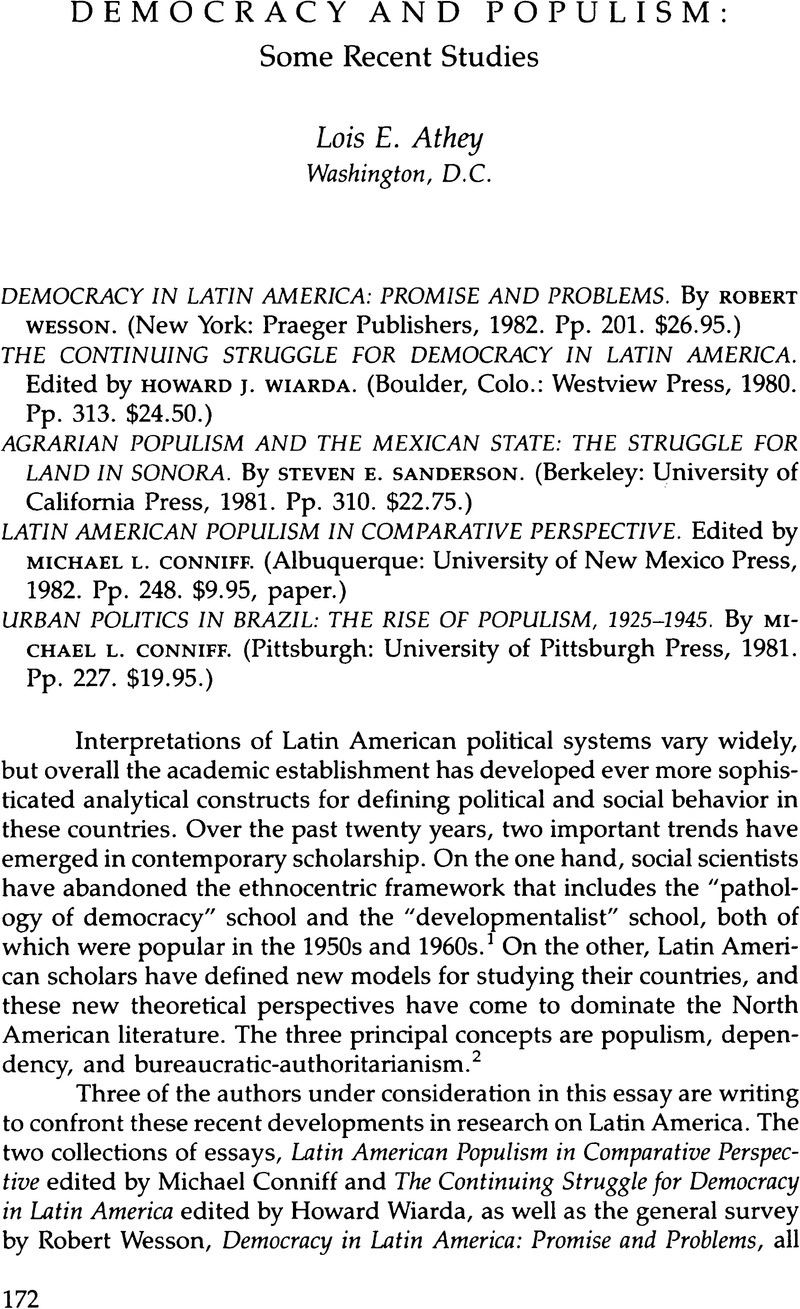No CrossRef data available.
Article contents
Democracy and Populism: Some Recent Studies
Review products
Published online by Cambridge University Press: 24 October 2022
Abstract

- Type
- Review Essays
- Information
- Copyright
- Copyright © 1984 by Latin American Research Review
References
Notes
1. In his concluding chapter, Wiarda summarizes these approaches in The Continuing Struggle, pp. 10ff. and pp. 277ff. In brief, the “pathology of democracy” school criticized the lack of democratic institutions and encouraged students to study constitutions and party systems that were meaningless in the Latin American context. The “developmentalist” school encompasses such diverse writers as Gabriel Almond, Samuel Huntington, and John Johnson. Latin American societies were supposed to progress along a continuum from traditional to modern. Traditional patterns such as personalism and military intervention in politics would disappear as the middle class grew in strength.
2. For the literature on populism, see the writings of Weffort, Alba, DiTella, and Ianni, as cited in Conniff, Latin American Populism, pp. 29–30. On dependency, the main Latin American sources are Cardoso and Faletto, Dos Santos, Quijano, and others as cited in Latin America: The Struggle with Dependency and Beyond, edited by Ronald H. Chilcote and Joel C. Edelstein (New York: Wiley and Sons, 1974); and Fernando Henrique Cardoso, “The Consumption of Dependency Theory in the United States,” LARR 7, no. 3 (1977): 7–24. The original work on bureaucratic-authoritarianism was written by Guillermo A. O'Donnell, Modernization and Bureaucratic-Authoritarianism: Studies in South American Politics, Politics of Modernization Series No. 9 (Berkeley: Institute of International Studies, 1973).
3. It should be noted that there is one exception: Wesson in Democracy in Latin America uses the following two terms when describing different countries: “exclusionary coup” (p. 61) and “incorporating political system” (p. 7).
4. For a fuller understanding of what Wiarda considers to be a “distinct” Latin American political system, the reader should refer to the following sources: Howard J. Wiarda, “Corporatism and Development in the Iberic-Latin World: Persistent Strains and New Variations,” in The New Corporatism: Socio-Political Structures in the New World, edited by Fredrick B. Pike and Thomas Stritch (Notre Dame: University of Notre Dame Press, 1974), pp. 3–33; Politics and Social Change in Latin America: The Distinct Tradition, edited by Howard J. Wiarda (Amherst: University of Massachusetts Press, 1974); and Howard J. Wiarda, Corporatism and National Development in Latin America (Boulder: Westview Press, 1980). Most recently, Wiarda has been appointed as Director of the Center for Hemispheric Studies of the American Enterprise Institute for Public Policy Research. His new essays relate more to current foreign policy issues: “The Crisis in Central America,” AEI Foreign Policy and Defense Review 4, no. 2 (1982), and Human Rights and U.S. Human Rights Policy: Theoretical Approaches and Some Perspectives on Latin America (Washington, D.C.: American Enterprise Institute for Public Policy Research, 1982).
5. Charles W. Anderson, Politics and Economic Change in Latin America (Princeton: Van Nostrand, 1967), chap. 4.
6. Some usual features are: separate and coequal parliament and courts, local government autonomy, political parties, legal and strong opposition, regular elections, and free speech.
7. January 1978 was the cutoff date used for ranking the countries.
8. After seven and a half years of military rule, Raúl Alfonsín came to power in December 1983 as the leader of the center-left Radical Civic Union party. Although writers differ over whether the Radicals can be considered populist, Alfonsín clearly represents a multiclass coalition that promises to unite Argentines under a democratic government. In Bolivia the veteran populist Hernán Siles Zuazo led a multiparty coalition to power in October 1982. After eighteen years of nearly uninterrupted military rule, Siles Zuazo heads the Movimiento Nacionalista Revolucionario de Izquierda, the leftist faction of the old populist movement that has dominated Bolivian politics since the 1950s.
9. David Collier, “The Bureaucratic-Authoritarian Model: Synthesis and Priorities for Future Research,” in The New Authoritarianism in Latin America, edited by David Collier (Princeton: Princeton University Press, 1979), p. 372.
10. In addition to the books under review, the following studies on populism should be examined by the interested reader: Steve Stein, Populism in Peru: The Emergence of the Masses and the Politics of Social Control (Madison: University of Wisconsin Press, 1980); Christopher Mitchell, The Legacy of Populism in Bolivia (New York: Praeger, 1977); A. E. Van Niekerk, Populism and Political Development in Latin America (Rotterdam: Rotterdam University Press, 1974); Paul W. Drake, Socialism and Populism in Chile: 1932–52 (Urbana: University of Illinois Press, 1978); Lars Schoultz, The Populist Challenge: Argentine Electoral Behavior in the Postwar Era (Chapel Hill: University of North Carolina Press, 1983); Thomas E. Skidmore, “A Case Study in Comparative Public Policy: The Economic Dimensions of Populism in Argentina and Brazil,” The New Scholar 7 (1979): 129–66; Instituto de Investigaciones Sociales de UNAM, América Latina: historia de medio siglo, 2 vols., especially the articles on Argentina, Bolivia, and Brazil (Mexico: Siglo Veintiuno, 1977); and “Populismo” in Diccionario de política, edited by Norberto Bobbio and Nicola Matteucci (Mexico: Siglo Veintiuno, 1982).
11. John K. Chance, “Recent Trends in Latin American Urban Studies,” LARR 15, no. 1 (1980): 183–88.
12. Wiarda, Politics and Social Change in Latin America.




